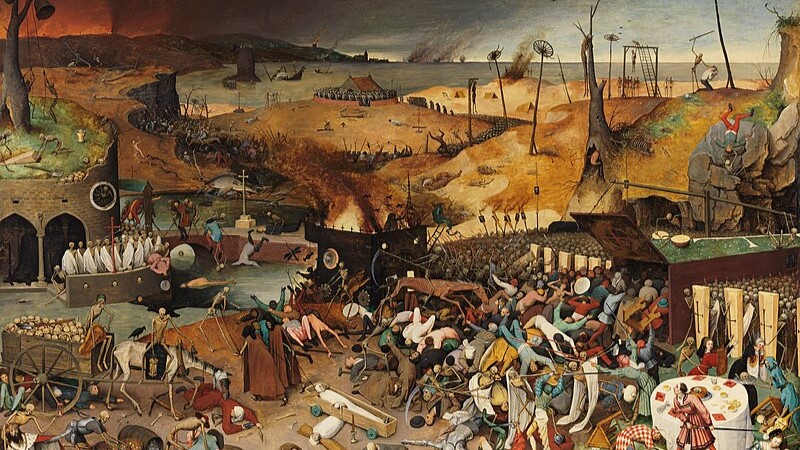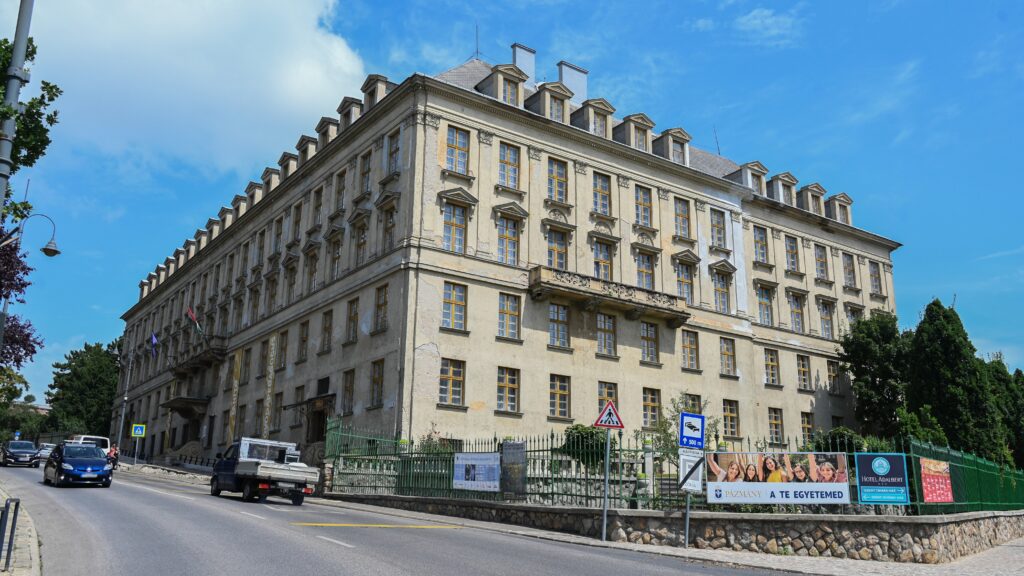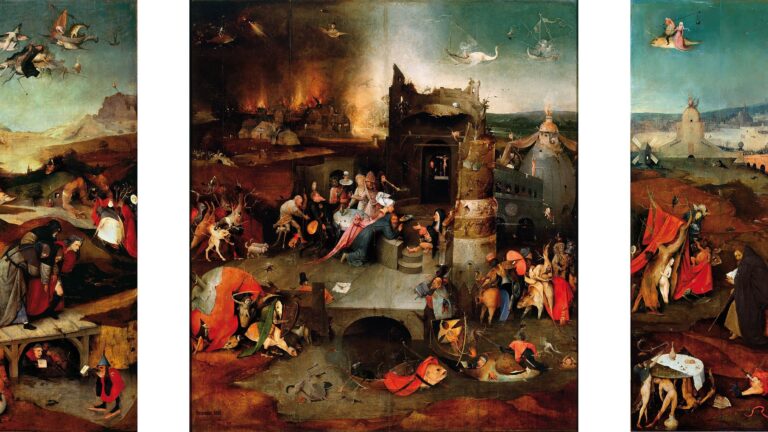In Europe, philosophy was the ‘handmaiden of theology’ (ancilla theologiae) until the end of the Middle Ages at the latest. However, with the development of modernity, philosophy became increasingly and rapidly detached from religion. Some thinkers have called this process the ‘Enlightenment’. Others, such as Kant, have postulated under the name of ‘Enlightenment’ a self-asserting, or ‘reason autonomous’, outlook, which also has an irreligious, if not explicitly anti-religious, aspect. All this follows from the idea of progress, deeply rooted in 17th and 18th century thought: this is the period in human history when philosophers first conceived of time and humanity as progressive.
In the pre-Christian ancient cultures, time was basically considered cyclical, circular. The world, and man in it, was born, flourished, declined, and then reborn again—this idea is reflected, for example, in the myths of the ‘Golden Age’ and ‘Silver Age’ of the Greek Hesiod. Christianity made time linear, but this did not imply real progression. In contrast to modern ‘progressive Christianity’, the ‘traditional’ understanding of Christianity is that linear ‘progress’ in time does not essentially imply progression, but the unfolding of a ‘divine plan’ in the history of the universe and humanity. Man begins from God and returns to God, and the state of the ‘end of history’ does not imply a qualitative transcendence of the beginning, since nothing can be ‘more advanced’ than God, who already sui generis includes all perfection. The idea of progress originated in the natural sciences: in the 16th and 17th centuries, new scientific ideas and discoveries (Copernicus, Galileo, Newton) were first introduced into philosophical thought as a concept of progress: if the world works according to rational laws, and if these laws can be known, man is capable of knowing and shaping reality, of gradually ‘improving’ it.
Kant is a good example of this optimism. According to him, humanity is gradually emerging ‘from its self-inflicted infancy’. This is true not only of scientific knowledge but also of religion. If reason is free from dogmatic constraints, the possibility of a ‘rational belief in God’ will soon open up to man:
‘If we are asked: “Do we now live in an enlightened age?” the answer is: “No”, but we do live in an age of enlightenment. As things now stand, much is lacking, which prevents men from being, or easily becoming, capable of correctly using their own reason in religious matters with assurance and freedom from outside direction. But on the other hand, we have clear indications that the field has now been opened wherein men may freely deal with these things and that the obstacles to general enlightenment or the release from self-imposed tutelage are gradually being reduced…’
Today, 250 years after Kant, at least in the western half of the world, we can see the results of this process more clearly. Over the last 300 years, the earlier obstacles to man’s ‘use of reason’ have gradually disappeared. Undoubtedly, the general constraint of religiosity, at least in the Western world, can thus be regarded as having been removed. In a sense, the Kantian hopes have been fulfilled; the ‘free’ use of reason is in principle no longer restricted.
Today, no one is expected to practice or adopt a dogmatic religion when applying for any job; faith is, so to speak, a truly private matter. Let us look at the bright side of the process: obviously, anyone who wants to can indeed think freely about religion and express his views. However heretical he may be in terms of a dogmatic religion, he can argue for it without penalty or retribution. But it is far from that simple.
The great naivety of Kant and other ‘enlightened’ philosophers was their inability to show genuine empathy—that is, they failed to take into account that, unlike themselves, the ‘man in the street’ is not a born thinker or theologian, but quite the opposite. His attention, not only in the modern world but also in historical records from the European Middle Ages and Greco-Roman antiquity, is primarily occupied with the concerns of everyday life. Only in rare moments does he pause to ask, if he asks at all: ‘Why am I here?’. This is not an elitist statement, but a factual observation. People’s thinking is generally tied to concrete, material, and distinctly bodily processes of perception; few people are capable of the detachment from the concrete that is necessary for religious or theological reflection.
Few people, and these individuals, rarely attain the high level of clear thinking that deals not only with results and facts, but also with origins and causes. Such thinking was at least better appreciated in antiquity and the Middle Ages, but under the conditions of general pragmatism in the modern world, such ‘over-theoretical’ interest, according to its pragmatist and anti-philosophical critics, has lost what little social appreciation it had left.
For the smooth functioning of social and political institutions, a large part of the population in general—this is true for all ages and populations—needs a more or less simplified ideology. This is usually enough: for the few in whom there is a need to detach themselves from the concrete, they need an easily grasped and ‘unambiguous’ view in order to make sense of their own existence: an ideology that has been thought up not by them but by others. The average person has neither the inclination, nor the time and the education (and often the ability) to think coherently about such a thing, and this is precisely what Kant’s ‘dogmatic religions’ offered him. What has happened since thinking about religion has been ‘freed’, so to speak, from the ‘shackles’ previously imposed on it?
‘Although the traditional Christian image of God is still held by a large part of the population, it has less and less influence on the course of everyday life’
Atheism today is not only possible; it has also become—at least in the western half of the world—a kind of guiding viewpoint. Although atheism is still not universal across Europe, the rate of religiosity has fallen by the beginning of the 21st century compared to any previous century. The 2010 Eurobarometer survey distinguished between three types of belief. One option was that the person ‘believes that God exists’, another that they ‘believe in the existence of a spirit or life force’, and the third was ‘do not believe that any spirit, God or life force exists’. In Hungary, for example, the distribution of responses was as follows: 45 per cent believed in the traditional Christian image of God, 35 per cent believed in some image of God and 20 per cent openly professed atheism. In other countries—not only former communist countries, but also in countries such as the UK and Finland—the proportions were: 37 per cent, 33 per cent, 25 per cent (UK) and 33 per cent, 42 per cent, 22 per cent (Finland). In the United States, the situation is somewhat different: although the majority seem to believe in a ‘higher power’, agnosticism and atheism are on the rise.[1] Although the traditional Christian image of God is still held by a large part of the population, it has less and less influence on the course of everyday life.
The real question, however, is not whether people in general, if asked, think there may be a ‘higher power’, but how this influences their lives. In the West today (both in Europe and America), whether one believes in such a ‘higher power’ or not, this belief or viewpoint has very little influence on the general course of life, except for a minority who cling to the traditional Christian view of God.
The idea of God, whatever the outline or image, is generally barely present in culture and popular thought. The general increase in atheism is not, of course, only due to the weakening of large, organized historical religions. Contrary to Kant’s expectation, what has happened is not that the human race, beginning to use its reason universally, has arrived at some kind of ‘pure reason’ and that the dogmatic or confused image of God has been replaced by some sort of clearer, more rational image of God, but that a significant part of humanity has come to atheism, to the contempt or mockery of any image of any God.
With the weakening of the traditional religious worldview and its retreat from public life, earlier explanations of the origin of life, the world, and humanity have not been replaced by religious or philosophical ‘freethinking’, but rather by explanations dressed up as ‘science’. These are, in fact, examples of popular science that reflect philosophical materialism (and its variants, such as naturalism and emergentism), along with various positivist ideas. This is a profound difference.
Precisely because, contrary to Kantian hopes and expectations, man does not generally ‘use his mind’, or rather, he does not generally use his mind to think too coherently about ontological and metaphysical problems. When asked for his opinion on such matters, he is satisfied with an explanation that more or less seems coherent and that the majority accepts. It is not really a question of a clearer image of God, but of an exchange of ideologies. In the first part of this paper, we will not examine which ideology, ‘religious’ or ‘non-religious’, is ‘more true’, but which has the consequence and impact on the long-term life of humanity and the planet.
If the global processes and trends of the present world could be assessed in a generally positive way, if it could be said that the general rise of atheism and the ideas of ‘popular science’ about the purpose of life, the origin of the world or the origin of man had actually brought ‘something good’—then there would be a point in the argumentation of atheists, on which even those who do not call themselves atheists should reflect.
The most aggressive and most coherent way atheism has been spread in the world so far has been by Soviet-style communism. The physical victims of this openly atheistic and materialistic ideology are put at almost 100 million by The Black Book of Communism.[2] When we consider that communism first came to power in Russia just over 100 years ago, this is indeed a thought-provoking ‘achievement’. The distinctively modern problems of contemporary Western society today, however, are not primarily related to communism, but rather to practical materialism—very closely linked to the ecological crisis that threatens the very existence of humanity—the general standardization of life, cultural emptiness and value relativism, political demagogy, growing dependence on technology and the fragmentation of generational chains. The question is, how is all this linked to the spread of atheism in the Western world?
Since, in fact, we can only gain knowledge of different times and eras a posteriori, it is easy to say, ‘every age has its own problems’. The pre-modern, ‘religiously’ oriented ages undoubtedly had their own and different problems, which we could only really judge correctly if we were alive then and now, which is impossible. However, the undoubted problems of religious societies do not in any way relativize or neutralize the distinctively modern problems of modernity.
Compared to the age of Kant and the Enlightenment, speculation about the ‘progress of humanity’ today, if for no other reason than the pervasive presence of the global ecological crisis, is less and less serious. (Instead of ‘progress’, progressives today talk about ‘sustainable development’.) The crisis of the natural environment and its connection with the overuse of modern technology is a fact that can hardly be denied without denying reality. Its scale, of course, is debated—some try to minimize it, others portray it as apocalyptic in proportion—or else it is treated as though it were the only problem.
Ideological processes and their consequences in modernity cannot be too sharply separated. If an ideology that openly and unequivocally denies God, the soul, and the spirit has led to at least 100 million deaths in less than a century—according to conservative estimates—this cannot be relativized by pointing out that earlier religious wars or the persecution of heretics in Western Catholicism also caused many deaths. There was no communism in the Western world, but if nature is no longer sacred, it can be just as uninhibitedly oppressed, exploited, and destroyed as man is, according to the communists. The principle of consumption (or more precisely, the fetishization of this principle), which appears in Western advanced capitalism and characterizes, to a large extent, the so-called welfare societies, suggests a similarly sinister vision. Obviously, neither is unconnected with the phenomenon of disembeddedness and the dissemination of materialist ideology as science, which has emerged with a strong emphasis in both the capitalist and the former socialist world.
How do societies, in which religions have prevailed, relate to this phenomenon? As we have seen, these societies obviously had their own problems. However, no matter how simplistic their images of existence or the nature of God may have been in the historical realm, in socially unfolded religions, religious societies were capable of something that atheistic and materialistic societies lost: they enabled their members, at various levels, to find their way in the world and to find meaning in their existence. Obviously, religiosity—like the concept of ‘religion’ itself—is a very broad category. Instead of ‘religious’ and ‘irreligious’, it would in fact be more correct to speak of transcendental religion and materialistic religion, respectively—here, however, for the sake of ease in handling the problem, we will speak of religious and non-religious societies.[3]
In the context of general historical and civilizational knowledge today, we cannot speak of a single religion, or of the image of God generally accepted by, for example, the Christian tradition, as if it were the only possible, true, or conceivable image of God. This is not relativism but fact: thinkers who do not take into account images of God other than the Christian one, or who consider them ‘false’, are unable to talk meaningfully about the religious phenomenon itself. If we want to grasp the phenomenon of religion in simple terms, we can understand it as a system of ideas—coherent within its own systemic conditions—that explains the fact of existence in terms of some higher meaning.[4]
‘Thinkers who don’t take into account images of God other than the Christian one…are unable to talk meaningfully about the religious phenomenon itself’
Societies that can be considered ‘religious’ in the classical sense—that is, broadly speaking, pre-modern societies (and this category includes all pre-modern societies)—provided man with conditions that implanted the idea of reason and order, above all else, in the minds of the masses. Hence, the ‘static’ and ‘stable’ nature of religious societies, and the solid hierarchy of values that prevailed in such societies. In almost all religious societies—whether we speak of China before the ‘Cultural Revolution’, Tibet, which elevated Buddhist culture to a high level, or even medieval Christian Europe—traditional, hierarchical, and static forms of society prevailed. It is obvious that this is not independent of the general idea of a world order—if we assume a conscious and supreme principle above matter, it is impossible to transcend this principle. In such an order, the principle of social hierarchy and the ranking of the different dimensions of existence are natural.[5]
According to the premodern view, the world is also hierarchically structured and consequently consists of myriad levels of existence, from the lowest mineral level (which is the most material) to the highest: God, who is conceived as pure spirit and the ‘fullness of being’. In the medieval Christian world, for example, this was defined as God, the ultimate principle of everything, being also the absolute measure of everything; the whole hierarchy depended on his existence and was simultaneously directed towards him. He was the one who held the world together from the highest to the lowest. Be it the distinction of the lower worlds, the terrestrial world, and the upper worlds; be it the distinction of the mineral, vegetable, animal, and human forms of existence; or be it the nine successive belts of the Moon, Mercury, Venus, Sun, Mars, Jupiter, Saturn, and the fixed stars (ie the angels, archangels, and thrones), these all describe the hierarchical (metaphysical) degrees of existence from a given aspect. In non-Christian religions and cultures (such as Uralic and Altaic shamanism), world tree representations—found in almost every part of the world—depict the same hierarchically ordered nature of the world. The top of the world tree reaches to the sky, and in Uralic and Altaic mythologies, one of the most important tasks of the shaman is to symbolically ‘climb’ the world tree, ie, to reach the sky where the supreme deity ‘dwells’.[6]
It is obvious that progressive intellectuals, already at the dawn of the Enlightenment, criticized religiously infused worldviews as obstacles to progress, and saw the role of churches and religion in general as responsible for the preservation of social conditions—in a negative sense.
The idea of social and political progress could not really take root in societies imbued with such spiritual principles, but the idea of development was, in a certain sense, present—not only in the world of high theology or in the understanding of mystics who wished to unite with the Divine, but also in the context of the ordinary man. One of the most important keys to understanding the essential differences between religious societies and materialistic–atheistic societies lies precisely in the change of concepts and goals, and in the dialectical reversal of the most important goal. If we compare the idea of inner, spiritual development, which is the most important goal of all the great religions, with the idea of modern progress, we must not assume a gradual improvement towards a future, external, and material goal, but rather an inner goal, which is not to be found in the objective world, but in the direction of the subject. The deepening of spirituality, or spiritual life, is the most important goal for the inner development of the individual in religious societies. If the individual wishes to improve his living conditions in a real and conscious way, he must first of all ‘go’ in this direction: the more he approaches it, the more his results become meaningful.
The prevailing religious ideologies of the premodern world excluded moral, existential, and cosmic nihilism. Although nihilism today is not a direct problem for everyone—or rather, a problem that most individuals in society are unaware of, precisely because of pragmatism—it lies at the root of everything that shapes the negative face of modernity: from the ever-increasing exploitation and destruction of the natural environment to the inversion of social and value hierarchies. The idea of the survivability of death is a key problem, because in its light the whole of life takes on a completely different meaning: if it is possible, nothing else is more important than this; if it is not possible, nothing else is more important than maximizing power and profit in the short period of life on earth—which submerges all other goals.[7]
All religious systems of thought have assumed that, because the soul (or non-material consciousness) exists in some form, it can be conceived independently of the body, and death is therefore survivable. Obviously, this cannot be proved in the empirical sense of the word, but to think of it as psychological self-justification, or as an outgrowth of desire, is—precisely on the basis of scientific empiricism—a gross exaggeration, since no evidence can be gathered for the inevitable destruction of the soul or consciousness after death either, given the nature of it.[8] Where extrasensory or ‘occult’ perception was invoked in the religious worldview—such as in the journeys of shamans who spoke to ‘the dead’, or on the basis of deep meditative experiences—quasi-experiential evidence for the existence of an ‘afterlife’ was provided.[9]
The worldview defined by religions can be described in one word as certainty of existence: not in the modern and simplistic sense that the world around us is real and ‘not a dream’[10], but in the sense that they have defined a very definite hierarchy of values (this is true of all the great, historical religions) in which spiritual goals have always taken precedence over material goals. And the most important spiritual goal for every human being is the presupposition of the possibility of spiritual ascent. This means, above all, not the accumulation of data and knowledge for its own sake or for ‘social purposes’, but the promotion of a positive survival of death and thus the realization of ‘closeness to divinity’—ie, in philosophical terms, the integration of a consciousness that knows itself as a human being into the spiritual principle of the world.[11]
‘The most important goal, towards which the overwhelming majority of society strives, is to accumulate as much wealth as possible’
In the religiously infused world, material wealth was certainly not considered a more important goal than any other. In the modern world, where atheism and materialism have a prominent position, there is also talk of ‘spiritual elevation’, but in practice, the picture is quite different—the most respected, envied, and ‘important’ people are those who are materially the richest; at the top of the value hierarchy are the ‘well-paid’ professions; the most important person is the successful and ‘prosperous’ businessman. The most important goal, towards which the overwhelming majority of society strives, is to accumulate as much wealth as possible.
What has only recently become clear is how anti-cultural the tendency towards what can be called social economism is in its final analysis; how deeply it is linked to atheism and materialism; how completely it is able to permeate the life of society with the cult of objects and ‘products’; and finally, how ruthlessly it subordinates the higher, non-economic functions of the human spirit to the somewhat utopian notion of happiness through fetishized material well-being. We find quite blatant examples of this in today’s society.[12] Since ‘spirituality’ in modernity is fundamentally understood as factual, practical, and mental knowledge—or the accumulation of knowledge—the idea of ‘spiritual elevation’ becomes similar to the idea of material accumulation: the quantitative and data-like accumulation of knowledge operates on the very same principle as material enrichment, rather than through the negotiation and vision of deeper connections or substantive problems. It is impossible to separate this image from the ‘denials’ of atheism in terms of substance: the idea of material accumulation as an absolute value is inseparable from the systematic destruction of the natural environment and the inversion of the hierarchy of values. The most respected man is the one who has the greatest material gain—regardless of his moral, intellectual, or spiritual level.
[1] ‘The vast majority of people—approximately 80 per cent—describe themselves as both spiritual and religious. Still, a small but growing minority of Americans describe themselves as spiritual but not religious, as Figure 3.4 shows. In 1998, 9 per cent of Americans described themselves as at least moderately spiritual but not more than slightly religious. That number rose to 16 per cent in the 2010s.’ (Mark Chaves, American Religion: Contemporary Trends, London, Princeton University Press, 2017, pp. 38–39.)
[2] According to the introduction, the number of people killed by the Communist governments amounts to more than 94 million. (Stéphane Courtois, The Black Book of Communism: Crimes, Terror, Repression, Harvard University Press, 1999.)
[3] In this sense, for example, Soviet-style communism or related (or unrelated) atheistic materialism is a kind of religion in which a mystical ‘primordial matter’ plays the role of God, even if they are explicitly created for ‘anti-religious’ purposes, as opposed to transcendent religions. The materialist, though never having seen it empirically, believes in the ‘idea of pure matter’ and that there is a certain principle or first cause that determines his existence and thought. Materialism, as it has appeared in modernity, especially in Marxism, is itself a distinctively post-Christian, quasi-mystical ideal—it believes in an inverted ‘first cause’ in a causa sui that it regards as simply material or non-transcendent transcendence. The materialist, in fact, sees only things that he says are ‘of matter’ but not matter itself. He should regard it as a purely abstract spiritual being since he cannot observe it.
[4] The atheistic solutions to the ontological problems adopted in the contemporary Western world by worldviews called ‘scientific’ or ‘non-ideological’ are simply based on exclusion and suppression, ie they are in fact either materialistic or they avoid the question of existence by not assuming any principle or basis substance. However, this second solution, in contrast to pure materialism, which accepts matter as the ‘first cause’, can hardly be considered coherent thinking. For example, in the case of consistently applied empiricism or positivism, there are specific cases of one-sided paralysis: for they are incapable, in the absence of a presupposed substance, of even taking up the questions of ‘what it is that something is’ or ‘how things are’. Positivists and empiricists also forget that even the possible ‘non-asking’ of questions takes place in the subject (mind)—the acceptance of which is necessary for one to think at all.
[5] A medieval-neoplatonic formulation of this refers to the ‘great chain of Being’.
[6] Mircea Eliade, Shamanism. The ancient techniques of ecstasy, Budapest, 2002, Osiris Publishers, pp. 139–140.
[7] It is not true that modern man is not interested in the problem of surviving death. As Hungarian philosopher Lajos Prohászka puts it so eloquently in his study, The Tragic Life Experience of Ákos Pauler:
‘…No one has expressed this constant uncertainty, this metaphysical loneliness, with more despair than Pascal: “the eternal silence of these infinite spaces fills me with terror…” This terror, this fear of death, is the basic conception of modern man, the only haunting that confronts him everywhere, more cruel than the ancient Moira, more terrifying than the eternal damnation of the Christian Middle Ages, for it is Nothingness.’ (Lajos Prohászka, Történet és kultúra, (ed) Orosz Gábor, Hamvas Béla Kultúrakutató Intézet, Budapest, 2015, pp. 484–486.)
[8] The objective sight or experience of any corpse is projected in consciousness not in terms of ‘my death’ but in terms of ‘the death of another’: If I can deny or justify everything based on my experiences regarding life after death, then I have nothing to say until I have personally ‘experienced’ my own death.
[9] Of course, this ‘quasi-proof’ did not say that the methods of ordinary empiricism can prove the existence of a soul separate from the body, but that there are states of being other than the general conditions of the earthly world, or higher states, into which it is—in principle—possible to enter.
[10] This last statement is not true precisely in the context of the experience of the reality of the most dominant Eastern religions, Hinduism and Buddhism. Hinduism and Buddhism basically describe apparent or material existence in terms of ‘illusion’ or ‘magic’ (máyá).
[11] By ‘positive survival’, we mean the ‘two ways’ put forward by most religions: one is hell (or something similar), the other is ‘heaven’. Although these concepts are strongly moral in nature in Christianity and Islam, they can also be raised in other ways, as in Buddhism. Some religious thinkers have also spoken of ‘conditional immortality’ after death and the possibility of the annihilation of the soul.
[12] A prominent Hungarian political scientist, László Ottlik, for example, in the 1930s, put it this way: ‘absolute liberalism is the reduction of politics to the minimum that protects the free activity and security of homo economicus’, while free competition ‘mercilessly crushes those who are not born to earn their bread in business and do not give themselves to their vocation with heart and soul.’ (László Ottlik, In Ottlik, Gyula Kornis, Gusztáv Gratz, Lóránt Hegedűs, Emil Schimanek (eds), The Picture of Today’s World, Budapest, 1939, Royal Hungarian University Press, pp. 361–530, p. 381.)
Related articles:







